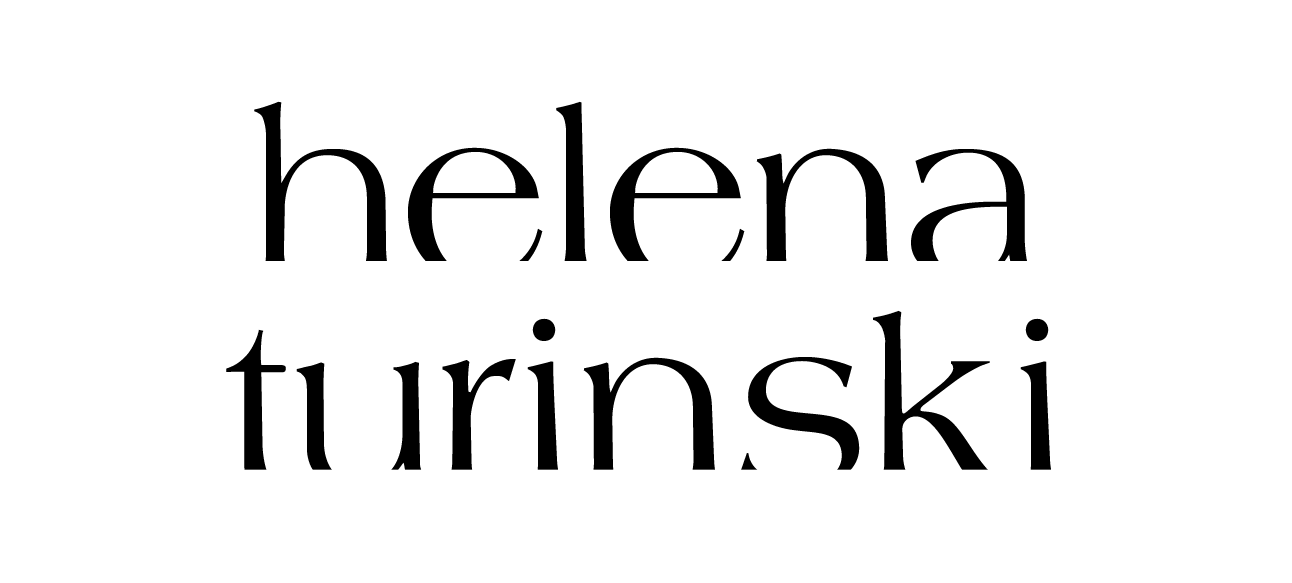Archive
- Behind the Screens 9
- Bright Young Things 16
- Colour Palette 64
- Dress Ups 60
- Fashionisms 25
- Fashionistamatics 107
- Foreign Exchange 13
- From the Pages of… 81
- G.U.I.L.T. 10
- Little Trifles 126
- Lost and Found 89
- Odd Socks 130
- Out of the Album 39
- Red Carpet 3
- Silver Screen Style 33
- Sit Like a Lady! 29
- Spin, Flip, Click 34
- Vintage Rescue 20
- Vintage Style 157
- Wardrobe 101 148
- What I Actually Wore 163
Walking Papers
 When I was in my late teens I started to wear broad-brimmed hats in summer for protection from the sun simply because I loathed the stickiness of sunscreen and decided I would only put up with it at the beach. From sun hats to parasols was a small step, and I began to collect parasols – because if a hat gave you some protection from the sun, how much more a parasol? (And from summer hats to their winter counterparts was a small leap, and thus a lifetime love affair with hats was born.)
When I was in my late teens I started to wear broad-brimmed hats in summer for protection from the sun simply because I loathed the stickiness of sunscreen and decided I would only put up with it at the beach. From sun hats to parasols was a small step, and I began to collect parasols – because if a hat gave you some protection from the sun, how much more a parasol? (And from summer hats to their winter counterparts was a small leap, and thus a lifetime love affair with hats was born.)
The first proper parasols I found were Chinese and Japanese oiled and plain paper parasols in thrift stores. They were not something I found often, but when I did they were usually inexpensive: under $10, some even under $5. The most recent acquisitions are the two that I am carrying in these pictures. I was thrilled with the flower-shaped one (possibly a Japanese one, with its cherry blossom painting), and the small one I deemed was very convenient to carry in my tote. And since I took this photo, I have found yet another – a green paper parasol.
I did see one oiled paper umbrella once which was priced around $20, but since it wasn’t significantly different to the ones I owned already, I passed on it. A quick look on Etsy ascertains that $20 is a very low price; there are many for $80 or more.*
 I always assumed that the coated paper parasols were lacquered, but in fact they are oiled to make them waterproof. As the oiled paper ages it becomes rigid, and easier to break, but with sufficient care one should last for 20 years. I suspect mine are past their use-by date and won’t test them out in the rain, although I’d love to!
I always assumed that the coated paper parasols were lacquered, but in fact they are oiled to make them waterproof. As the oiled paper ages it becomes rigid, and easier to break, but with sufficient care one should last for 20 years. I suspect mine are past their use-by date and won’t test them out in the rain, although I’d love to!
 Japanese family group, 1920s. (Image found on Pinterest; no original source linked.)
Japanese family group, 1920s. (Image found on Pinterest; no original source linked.) Kyoto 1955, by Kansuke YamamotoAccording to Wikipedia, the oiled paper umbrella originated in China, and spread to Korea and Japan during the Tang dynasty (7th–10th centuries). Early umbrella materials were mostly feathers or silks and only later were they covered in paper; it’s unknown when the oiled paper umbrellas were invented. You can read an interesting history about the Japanese wagasa (umbrella) and how they are painstakingly created by hand here. It’s not surprising to learn that the craft has dwindled after WWII, when synthetic umbrellas made their way to Japan. Today production of handmade wagasa is very limited.
Kyoto 1955, by Kansuke YamamotoAccording to Wikipedia, the oiled paper umbrella originated in China, and spread to Korea and Japan during the Tang dynasty (7th–10th centuries). Early umbrella materials were mostly feathers or silks and only later were they covered in paper; it’s unknown when the oiled paper umbrellas were invented. You can read an interesting history about the Japanese wagasa (umbrella) and how they are painstakingly created by hand here. It’s not surprising to learn that the craft has dwindled after WWII, when synthetic umbrellas made their way to Japan. Today production of handmade wagasa is very limited.
If I ever go to China again, or to Japan, a new one will definitely be on my list of desirable souvenirs. I wonder if anyone makes feather ones? What a fashion statement that would be – something else to add to my list of Holy Fashion Grails!
 Parasols on the beach, 1920s; click through to the link and scroll to the very bottom of the page to read more about beach parasols in this era.
Parasols on the beach, 1920s; click through to the link and scroll to the very bottom of the page to read more about beach parasols in this era. A lovely modern image of a woman with an umbrella in the snow
A lovely modern image of a woman with an umbrella in the snow
Fashion Notes
I am wearing a classic Chinese-style silk blouse with mandarin collar and frog fastenings by Sarah-Jane, which I found in a thrift store in country Victoria; the pants are modern, by a French label bought online. My bangles, ring and earrings are cloisonné, also found in thrift stores; the technique of cloisonné had spread to China by the 13–14th centuries where it became hugely popular; to the present day it is one of the world’s best known enamel cloisonné. The fabric necklace of insects and flowers was a souvenir from Hang Nga Guesthouse, popularly known as “Crazy House” for its architecture in Da Lat, Vietnam, and likewise, the beaded and embroidered slippers are a Vietnamese souvenir, bought in the main market in Saigon.
*All prices in Australian dollars
Photos: March 2018
Domestic Exchange
 I haven’t posted a Foreign Exchange story for a long time, and that is sadly because I haven’t been travelling overseas for an equally long time, but this woeful tale has its beginnings in a foreign exchange swapped for another kind of exchange.
I haven’t posted a Foreign Exchange story for a long time, and that is sadly because I haven’t been travelling overseas for an equally long time, but this woeful tale has its beginnings in a foreign exchange swapped for another kind of exchange.
The story starts in Vietnam nearly ten years ago, where I had a kimono custom-made for me from sumptuous silk brocade. I took that robe home and wore it to death over ten years, wearing it almost every morning except on the hottest summer days.
The day eventually came when it dawned on me that the kimono was actually starting to look rather shabby. There were worn patches and frayed edges. In denial at the prospect of setting it aside, I decided to ignore this observation and kept on wearing the kimono for a while longer.
I’ve spoken before how ruthless I am about shabby shoes – once they start to look disreputable, I become relentlessly unsentimental and throw the offending shoes straight into the bin without a moment’s hesitation. This is not the case with favourite garments.
… it still hung on a hook in my bathroom where I could gaze upon it fondly and sigh reminiscently.
Eventually, I stopped wearing the kimono, but it still hung on a hook in my bathroom where I could gaze upon it fondly and sigh reminiscently.
One day in a fit of madness, I gathered my resolve and took it to my sister Blossom, who over the many years we have been sisters, has generously made and altered countless garments for me.
She – and her husband, an involved observer one afternoon as she and I examined a portion of my wardrobe that needed rescuing – both assured me that indeed the kimono was too shabby to wear any longer.
I’d had the idea that something could be made of the good pieces of fabric, and I made my revolutionary suggestion … A CUSHION!
 I know, brutal – shocking even, all things considered; I did suffer some pangs for a while. But I figured if I had a cushion I would put it on my favourite armchair and lean against it every day, and thus extend the life of the kimono.
I know, brutal – shocking even, all things considered; I did suffer some pangs for a while. But I figured if I had a cushion I would put it on my favourite armchair and lean against it every day, and thus extend the life of the kimono.
The cushion doesn’t match the rest of my interior décor at all, and my yellow gingham kimono, though cheery, is not in the slightest degree exotic, but I don’t regret the loss anymore. I actually have a large collection of vintage dressing gowns, and enjoy sometimes wearing a 60s rayon satin with a stylised floral pattern. (I don’t wear it often for my cat Mimi attacks me in rage when I do – I think because it’s too slippery in my lap for her liking – she’s very opinionated.)
Maybe I’ll go to South-East Asia again one day, and then I’ll have another one made.
Photos: June 2009, March 2018
The Berber Weightlifting Champ

I honestly don’t know how some of these tribal ladies don’t collapse under the combined weight of all this fabric and jewellery. The cloak is a dead weight, and I am quite literally carrying a millstone around my neck in the form of a traditional necklace made from stone beads – amongst others. The weight is truly staggering.
I am wearing a number of Berber items that I bought when holidaying in Morocco nearly two years ago, although I am not wearing a technically correct traditional Berber ensemble. Research online was not definitive as there are so many tribal and modern influences to sift through – I became daunted and gave up. This is, after all, only a fanciful evocation of a Berber lady. In general, traditional costumes are made up of layers of coloured woven cloths; pounds and pounds of jewellery, many pieces dripping with silver coins; and henna tattoos. (I probably skimped on the kohl too.)
 The 14th century Merenid Tombs, Fès, June 2011
The 14th century Merenid Tombs, Fès, June 2011
The most spectacular piece is the cloak. This may look like a carpet, but the Berber merchant I bought it from in Chefchaouen told me that it was a traditional cloak, worn to ward of the desert night’s chill. I am uncertain of its fibre content (so taken with the jingling sequins, I forgot to ask!), but it is woven in subtly complicated stripes and shaggy sections that have been interwoven with silver sequins that are a little tarnished with age. The tarnish only adds to its charm. It is incredibly heavy however. Currently it sits across the bottom of my queen size bed and has become a comforting weight at night – in the winter months at least. It looks decorative though, and it is such a lovely souvenir of my holiday. I saw many of these cloaks used as rugs, some in my room in the Marrakesh riad I stayed in.
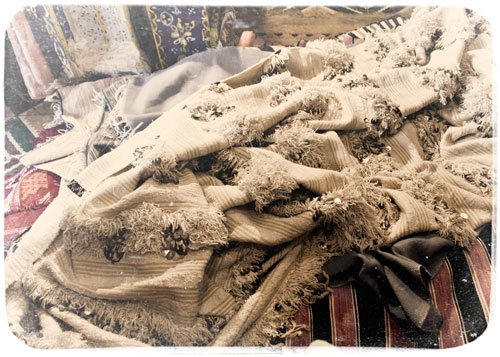 A pile of rugs shown to me, with my favourite on top
A pile of rugs shown to me, with my favourite on top The Chefchaouen Berber carpet seller modelling my antique cloak in his tiny store
The Chefchaouen Berber carpet seller modelling my antique cloak in his tiny store
 Underneath the cloak I am wearing a vintage Berber kaftan that the seller threw in as a bonus. He let me choose from many that were hanging high on the walls in his shop. I also chose another free item – a traditional belt – that unfortunately you can’t see very well in these pictures. It’s pale green, embroidered in white and pink, and is glued onto a cardboard backing.
Underneath the cloak I am wearing a vintage Berber kaftan that the seller threw in as a bonus. He let me choose from many that were hanging high on the walls in his shop. I also chose another free item – a traditional belt – that unfortunately you can’t see very well in these pictures. It’s pale green, embroidered in white and pink, and is glued onto a cardboard backing.
The kaftan is cream-coloured brocade woven with metallic silver thread – by the style I am guessing it dates back to the 60s or 70s. It’s quite scratchy to wear, and presumably it would have been worn with a cotton shift of some sort underneath. (As he recommended, I handwashed this in a gentle laundry detergent, and it washed up brighter. The belt I merely sponged, again at the seller’s advice.)
 Most of the jewellery is from Morocco. The chunky necklace is made up from stone, glass and shell beads and is so heavy I could not contemplate wearing it for more than a few minutes. The long coloured beads are all made from glass – one of the necklaces is about 3m end-to-end. All of these pieces came from the souqs in Essaouira. The coin earrings I am wearing are made from replicas of Turkish coins, and were bought in a Melbourne jewellery boutique that specialises in ethnic jewellery from around the world (mostly Arabia and Asia). Although the necklace looks tribal, it was bought from an Australian jewellery chain store, Lovisa.
Most of the jewellery is from Morocco. The chunky necklace is made up from stone, glass and shell beads and is so heavy I could not contemplate wearing it for more than a few minutes. The long coloured beads are all made from glass – one of the necklaces is about 3m end-to-end. All of these pieces came from the souqs in Essaouira. The coin earrings I am wearing are made from replicas of Turkish coins, and were bought in a Melbourne jewellery boutique that specialises in ethnic jewellery from around the world (mostly Arabia and Asia). Although the necklace looks tribal, it was bought from an Australian jewellery chain store, Lovisa.
 I do not know the provenance of the hat. I actually purchased it for 50c from the Australian designer Karen Merkel’s garage sale a few years ago. I was undecided on its purchase as the chains were broken and tangled, and they said I could have it for 50c. “How can you lose?” asked my friend Sapphire, who accompanied me. True. I untangled the mess and managed to figure out its repair.
I do not know the provenance of the hat. I actually purchased it for 50c from the Australian designer Karen Merkel’s garage sale a few years ago. I was undecided on its purchase as the chains were broken and tangled, and they said I could have it for 50c. “How can you lose?” asked my friend Sapphire, who accompanied me. True. I untangled the mess and managed to figure out its repair.
 The slippers are tooled red leather, bought in Fez. I originally purchased two pairs, one in pumpkin yellow, and this red pair; I wore the yellow as house shoes, and they did wear out rather quickly, so I keep the red pair for special occasions only.
The slippers are tooled red leather, bought in Fez. I originally purchased two pairs, one in pumpkin yellow, and this red pair; I wore the yellow as house shoes, and they did wear out rather quickly, so I keep the red pair for special occasions only.
Shopping Notes
If you are planning to travel in Morocco, here are some shopping tips. Obviously you must bargain, and not appear too eager etc – that’s just common sense. I was rather chuffed when my Berber carpet seller opened his eyes wide at my opening gambit and ultimately complimented me on my bargaining skills: “You bargain like a Berber!” (You offer half their asking price to start with, and then go slowly up.)
 I am not sure if he was merely flattering me, but for around €120 I bought the rug you see here and a vintage cloak, and had the kaftan, belt and a few bags of herbs and spices thrown in for good measure (most of which were confiscated by Quarantine at Melbourne airport). The textiles were very heavy though and did cost about $100 to FedEx home. (They arrived home the same day I did, and I believe the package had been opened for inspection by Customs.) I can’t imagine how much a rug like that would cost at home – probably up to $1000. The stone necklace was about $90, and five other necklaces for under $20.
I am not sure if he was merely flattering me, but for around €120 I bought the rug you see here and a vintage cloak, and had the kaftan, belt and a few bags of herbs and spices thrown in for good measure (most of which were confiscated by Quarantine at Melbourne airport). The textiles were very heavy though and did cost about $100 to FedEx home. (They arrived home the same day I did, and I believe the package had been opened for inspection by Customs.) I can’t imagine how much a rug like that would cost at home – probably up to $1000. The stone necklace was about $90, and five other necklaces for under $20.
The background image is of the 14th century Merenid Tombs overlooking Fès.
 View of Fez from the Merenid Tombs, June 2011
View of Fez from the Merenid Tombs, June 2011 The 14th century Merenid Tombs, Fès, June 2011
The 14th century Merenid Tombs, Fès, June 2011
Blue Lady of the Desert

When I was first planning my trip to Morocco early last year, I knew that the one place I had to visit was Chefchouen. I saw photos of this extraordinary town on Flickr and fell in love with it. The name Chefchouen actually means ‘look at the peaks’, but for me (and probably other visitors as well) it will be always synonymous with the celestial blue of its walls.
The town is small and uncrowded, and you’ll only meet the occasional donkey in the streets. It’s easy to explore, and difficult to get lost, so it makes a very pleasant introduction to Morocco (although I’d already had a day in Tangier the day before I arrived in Chefchouen). The owners of the shops are not at all intimidating and many of them even leave you alone to browse!

On one of my wanderings I found a carpet shop that also sold vintage clothing, and saw this cloak hanging on display outside. It was a case of instant love. Of course I could not simply purchase this cloak – I had to listen to the entire carpet selling spiel – but in the end I actually purchased a carpet too. The carpet seller told me he was a Berber (see him here), and that particular rug was originally an old Berber cloak. He draped it around my shoulders, and it was so heavy I can’t imagine wearing it for long periods of time. Those Berbers had stamina! I knew that bargaining was necessary, and was delighted when the man’s eyes widened in respect and he told me I bargained like a true Berber.
 Detail of the embroidery on the cloak
Detail of the embroidery on the cloak The Tuareg are known as the ‘blue men of the desert’The blue trousers are an exact match for the walls of the town, and I found them in another shop. The seller told me they were Tuareg trousers. They are actually extremely baggy at the top, narrowing just past the knees. There is some pretty galloon embroidery – narrow strips of braid that is sewn onto the fabric. In actual fact the trousers are quite unflattering; that’ll teach me to buy clothing without trying it on! I would have bought them anyway, just for the colour, but I declined to purchase the matching top as together they would be too much. Not too much for the Tuareg, the blue men of the desert, however, whom the seller informed me wore garments dyed such blues. The embroidered blouse I am wearing is actually from Zara in Portugal; it was similar to some of the blouses worn with traditional Portuguese dress.
The Tuareg are known as the ‘blue men of the desert’The blue trousers are an exact match for the walls of the town, and I found them in another shop. The seller told me they were Tuareg trousers. They are actually extremely baggy at the top, narrowing just past the knees. There is some pretty galloon embroidery – narrow strips of braid that is sewn onto the fabric. In actual fact the trousers are quite unflattering; that’ll teach me to buy clothing without trying it on! I would have bought them anyway, just for the colour, but I declined to purchase the matching top as together they would be too much. Not too much for the Tuareg, the blue men of the desert, however, whom the seller informed me wore garments dyed such blues. The embroidered blouse I am wearing is actually from Zara in Portugal; it was similar to some of the blouses worn with traditional Portuguese dress.
 Blue jewels (only the bead necklace is from Morocco, from the souqs of Essaouira)
Blue jewels (only the bead necklace is from Morocco, from the souqs of Essaouira)
I am wearing jewellery from a mixture of sources: only the blue glass bead necklace was bought in Morocco, from the souq in Essaouira. The earrings, featuring copies of Turkish coins, and the blue 1920s style ring were both from a Melbourne jewellery boutique, and the metal necklace I discovered in a Salvos thrift store.
Although the red tooled leather slippers are traditional Moroccan wear – these were bought in Fez – the velvet cap is not at all; I just thought it looked cute. It’s not quite a traditional Moroccan costume, but it is inspired by this most beautiful city of Morocco, Chefchouen.
A MINI CHEFCHOUEN TRAVEL GALLERY
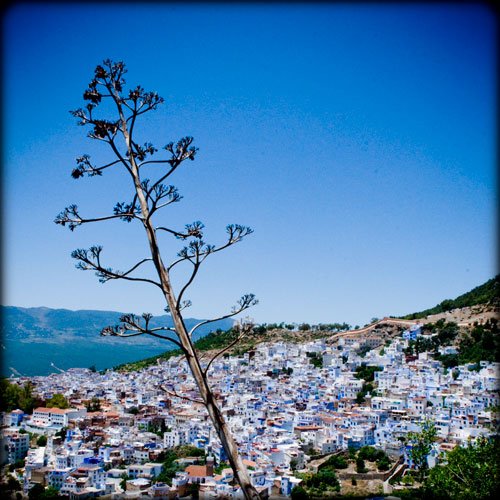 Looking down on Chefchaouen
Looking down on Chefchaouen Sacks of powdered dye are everywhere
Sacks of powdered dye are everywhere Stairway to heaven
Stairway to heaven Children playing
Children playing
Lisbon Meringue
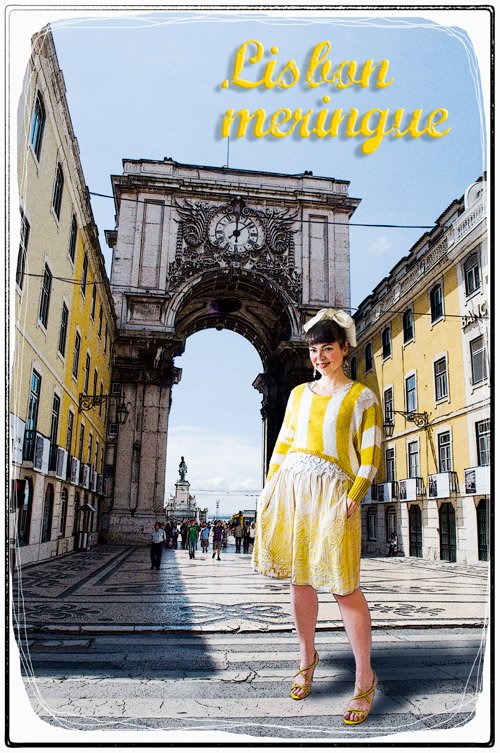 Standing in Rua Augusta, before the Arco da Victória Lisbon is a pretty city. Its buildings are like pastel-coloured wedding cakes, iced in white marzipan in thick loops and curlicues. Pistachio, apricot, strawberry, coffee – you’ll see them all, but it is the glorious lemon meringue of Praça do Comércio that takes the prize.
Standing in Rua Augusta, before the Arco da Victória Lisbon is a pretty city. Its buildings are like pastel-coloured wedding cakes, iced in white marzipan in thick loops and curlicues. Pistachio, apricot, strawberry, coffee – you’ll see them all, but it is the glorious lemon meringue of Praça do Comércio that takes the prize.
This enormous square is surrounded on three sides by 18th century colonnades, dripping with lemon butter and white frosting. The fourth is the riverfront, and everyone arriving by boat in Lisbon would disembark here and was greeted by this dramatic sight. Pass through the triumphal Arco da Victória and enter the city lying beyond the square.
In keeping with my mission to collecting the traditional dress of countries I holiday in, I had been looking for a Portuguese costume in Porto and Lisbon. As in Barcelona, I hadn’t had much luck: the only costume I found was not only prohibitively expensive (€250), but it was incredibly heavy. I could not possibly cart it through Portugal and Morocco.
 Traditional Portuguese dress – the costume I saw was made from heavier fabric, with simpler embroidery
Traditional Portuguese dress – the costume I saw was made from heavier fabric, with simpler embroidery
I tossed aside this scheme and thought of another: some kind of pretty, macaroon-coloured dress, preferably trimmed in guipure lace, was in order. I actually find one in my favourite boutique on the Rua Augusta – and yet I didn’t want to pay $120 for a scrap of polyester. I decided to find something else that evoked the Lisbon ambiance at home.
I knew I had a 60s lace shift in mint green that had a matching coat, but this wasn’t quite right. I hankered after yellow. Not just any yellow – it had to be the same golden colour of that enormous plaza.
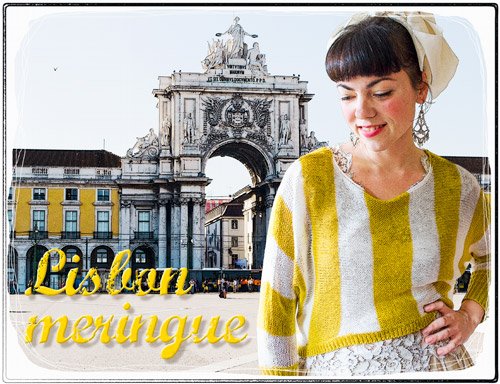 It took me a year to assemble this little confection of an outfit: an embroidered skirt by Anthropologie; a lace top by Karen Millen that I already owned; and the perfect awning-striped knit on eBay. I already had yellow strappy sandals and the pearl chandelier earrings too. The antique silk ribbon, from the turn of the last century, I found on Etsy. I originally intended to wear it as a sash, but an enormous floppy bow atop my head seemed the perfect finishing touch to this lemon meringue outfit.
It took me a year to assemble this little confection of an outfit: an embroidered skirt by Anthropologie; a lace top by Karen Millen that I already owned; and the perfect awning-striped knit on eBay. I already had yellow strappy sandals and the pearl chandelier earrings too. The antique silk ribbon, from the turn of the last century, I found on Etsy. I originally intended to wear it as a sash, but an enormous floppy bow atop my head seemed the perfect finishing touch to this lemon meringue outfit.
So sweet it makes my teeth ache, but I love all the yellow. A pretty outfit to greet spring with – minus the bow!



